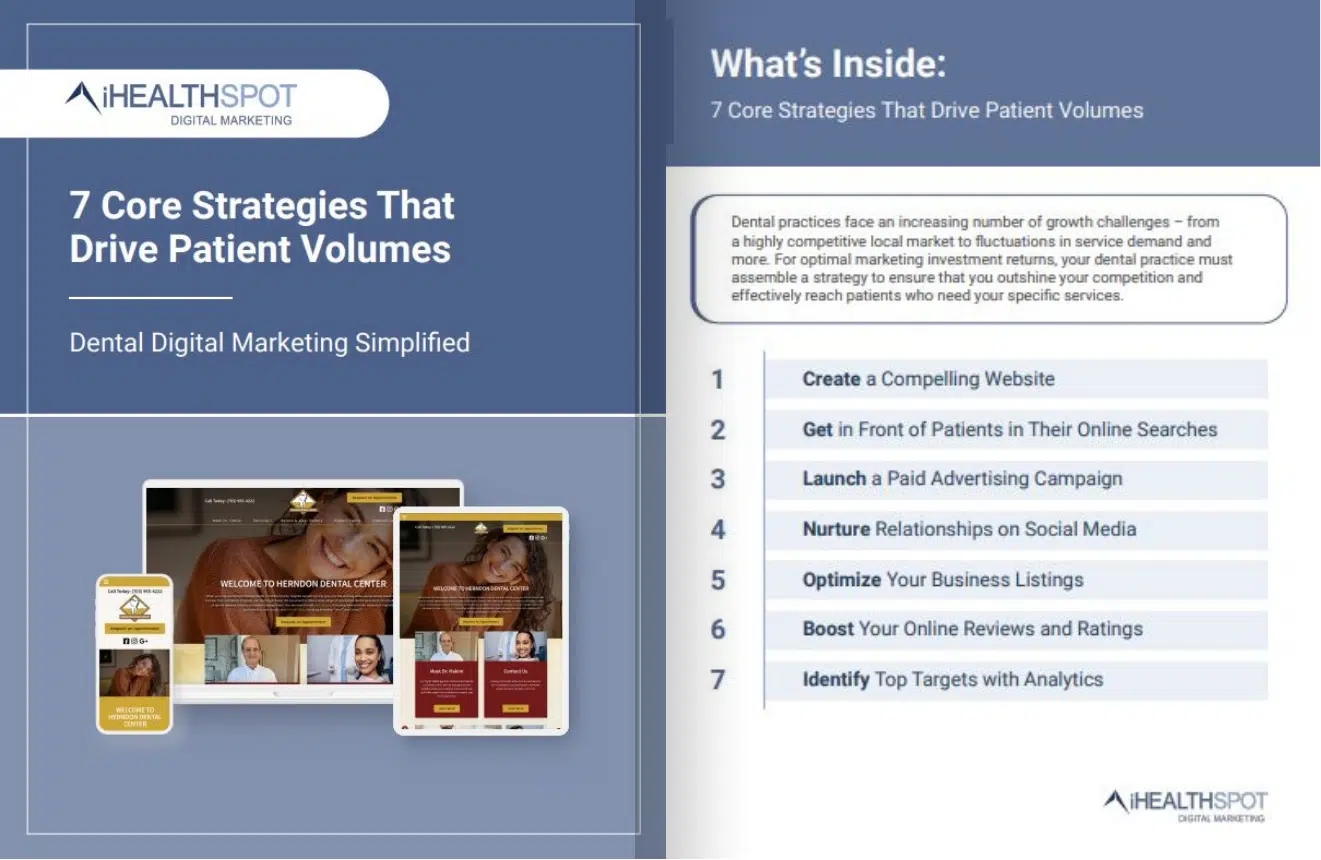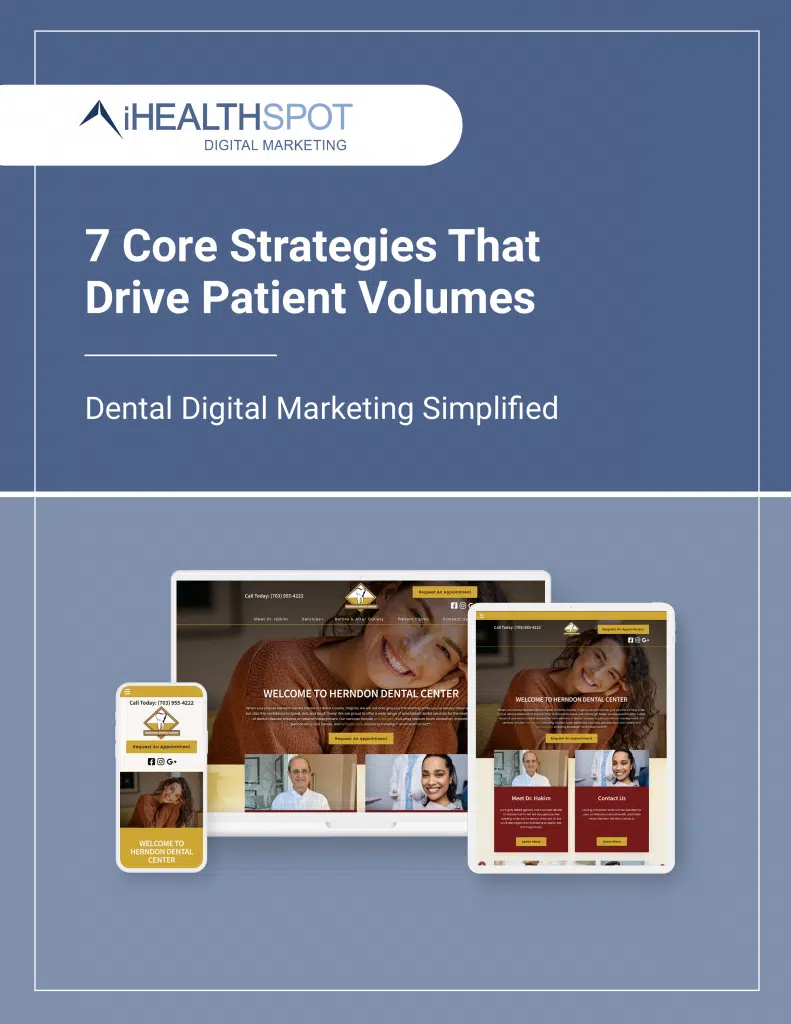DIGITAL MARKETING FOR DENTISTS
7 STEP DIGITAL MARKETING STRATEGY FOR DENTISTS
Regain growth mobility with smart digital marketing for dental practices.
Online marketing for dentists is an opportunity to cope with fluctuations in service demand, new entrants to the local market, and evolving consumer expectations – all factors impacting dental business growth.
Because so many dental consumers turn to the internet to find a new dentist, a robust online presence as a product of marketing for a dental office is essential to connect with those who actively look for dental services. Digital marketing for a dental office leverages the power of multiple channels to reach new patients, carving a path to consistent growth.


GET YOUR MARKETING STRATEGY FOR DENTISTS TODAY
Leverage our template marketing strategy for dental offices, developed to attract new patients, ensuring your practice remains at the forefront of your local market. This guide – available for download – unveils the intricacies of dental marketing for new patients, explaining how each aspect harmonizes to generate qualified leads.
Elevate your understanding by reading through our guide that helps you to make well-informed decisions for enduring growth. Our guide covers what you need to know now about dental marketing for new patients.
GET YOUR MARKETING STRATEGY FOR DENTISTS TODAY
Leverage our template marketing strategy for dental offices, developed to attract new patients, ensuring your practice remains at the forefront of your local market. This guide – available for download – unveils the intricacies of dental marketing for new patients, explaining how each aspect harmonizes to generate qualified leads.
Elevate your understanding by reading through our guide that helps you to make well-informed decisions for enduring growth. Our guide covers what you need to know now about dental marketing for new patients.
INSIGHTS YOU’LL GAIN THROUGH THIS FREE GUIDE
Learn everything you need to know about marketing your medical practice. Starting with your website and ending with booked appointments, this guide has everything you need to know.
1
What a medical website needs to have for a favorable patient experience that makes a great first impression
2
How to transform your website into a patient traffic magnet through search engine optimization (SEO) and content marketing
3
Paid advertising (pay-per-click, or PPC) equalizes search visibility between your competitors through premium placement
4
Social media’s role in reinforcing your medical practice’s presence online
5
The free tool that is a game changer in local search results: Google Business Profile
6
How patient online reviews are pivotal for the success of your digital marketing strategy
Download Your 7 Step Strategy Guide Now
Find out how to bring more visitors to your website, and how to make your website effective in capturing new patient interest.

THE BEST DENTAL MARKETING STRATEGY GUIDE FOR YOUR PRACTICE
Having a comprehensive marketing for a dental practice is like having a full set of teeth – it promotes confidence and utility when all is set in place and in alignment. Leveraging all the channels for online reach is an effective strategy for internet marketing for dentists, especially for those operating in saturated local markets. Our guide contains our tried-and-true marketing ideas for dental offices to bring in new business consistently. Topics include:
- What a dental practice website needs to have to promote a consumer experience that wins new business
- How your dental website can be turned into a patient traffic magnet through search engine optimization (SEO) that includes content marketing
- Paid search (pay-per-click, or PPC) potential to equalize search placement visibility between your dental practice and its competitors
- Social media’s role in fortifying your dental practice’s presence online
- Why optimizing Google Business Profile is an indispensable part of dental marketing strategy in the local market
- How online reviews – or the lack thereof – can make or break a dentist’s appeal to consumers
ABOUT iHEALTHSPOT: YOUR MARKETING AGENCY FOR DENTISTS
iHealthSpot partners with healthcare businesses (and only healthcare businesses) far and wide. Backed by many years of experience in marketing consulting for dental clinics, our signature solutions drive practice growth, patient engagement, and ultimately, practice revenue. As a premiere marketing agency for dentists, our comprehensive services are designed to help you thrive in the healthcare market by reaching more patients with an engaging online presence.
Every day, our teams deliver these dynamic marketing services for dentists:
- Track record of digital marketing success for specialties, including dentists
- Award-winning web design, designed to convert patients and promote patient loyalty
- Comprehensive, and data-driven marketing plans based on market intelligence that optimizes campaign performance
- Accountability for results through marketing support and monthly reporting
Download Your 7 Step Strategy Guide Now
Find out how to bring more visitors to your website, and how to make your website effective in capturing new patient interest.
Explore Our Other Resources

URGENT New Google Click-To-Call Terms (And HIPAA Concern)
Filed Under: Hedy & Hopp’s Podcast
A new development from Google could pose serious HIPAA compliance risks for healthcare marketers. In a recent We Are, Marketing Happy podcast episode from Hedy & Hopp, Jenny covers that the platform now requires advertisers to opt into call recording for its Click-to-Call feature, potentially leading to the recording of PHI or PII. This episode
Read More
Recap of HCIC24
Filed Under: Hedy & Hopp’s Podcast
In a previous podcast episode on We Are, Marketing Happy, Jenny welcomes Hedy & Hopp team members Shelby Auer, an Account Manager, and Taylor Fedderke, Marketing Manager, as they share insights from their experience at HCIC24 in Austin. The conference’s central downtown location, combined with great food, created the perfect backdrop for networking and exploring
Read More
AI Video and Image Editing 101
Filed Under: Hedy & Hopp’s Podcast
In We Are, Marketing Happy’s recent podcast episode, Jenny Bristow, CEO of Hedy & Hopp, chats with Drew Hardesty, President and CEO of Wonder Boy Media, about how AI is changing the game for video and image editing in healthcare marketing. They dive into how AI tools are helping marketers save time, spark creativity, and
Read MoreFrequently Asked Questions About Dental Marketing
With dental marketing, you can leverage powerful outreach tools and data analytics insights to maximize your online reach to consumers seeking your services. For example, if you are a dental practice who offers enticing finance options for services, those who lack insurance will be looking for you. Digital marketing for dental offices helps patients who need your payment flexibility and specialty care easily find your practice.
Most dental practices have a website, but many are not utilizing it to its full potential. Not only do you need a website that follows best practices for search engines optimization (SEO), you also benefit from activating multiple channels to bring more traffic to your website.
Dental practices should also consider if the website is set up to where it is easy to become a new patient. By providing a good user experience, you encourage engagement that makes a great first impression, and provides the seamless experience that dental consumers expect when they seek services.
SEO for dental is all about setting your website according to best practices set by Google, but also maintaining a good “quality” rating. The last thing that Google wants is to serve up websites in search results that are low quality. For that reason, it will only place in top search results dental practice websites that load quickly and do a decent job of communicating what the site is about and who it serves.
By working with an expert in dental SEO, you can easily identify what keywords need to be in your website content, so Google knows exactly who your services are relevant to. For example, a parent needs a pediatric dentist within 10 miles from the child’s school that offers payment arrangements for those without insurance. With a solid SEO strategy, you can use your website to attract this specific consumer. This content marketing strategy also includes regular blog posts that touch on topics relevant to your target audience.
Digital marketing works best when SEO and pay-per-click (PPC) work together in tandem. SEO is a long-term strategy that may take a while to build momentum, but paid ads through major platforms like Google or Facebook will help you gain high-visibility placement where your competitors are. Working with an agency that specializes in dental advertising, you will have help navigating your campaigns through regulatory boundaries.
Absolutely! Feel free to explore some of our related marketing strategy guides and resources: Marketing Strategy For Medical Practices | Orthopedic Marketing
Download Your 7 Step Strategy Guide Now
Find out how to bring more visitors to your website, and how to make your website effective in capturing new patient interest.













